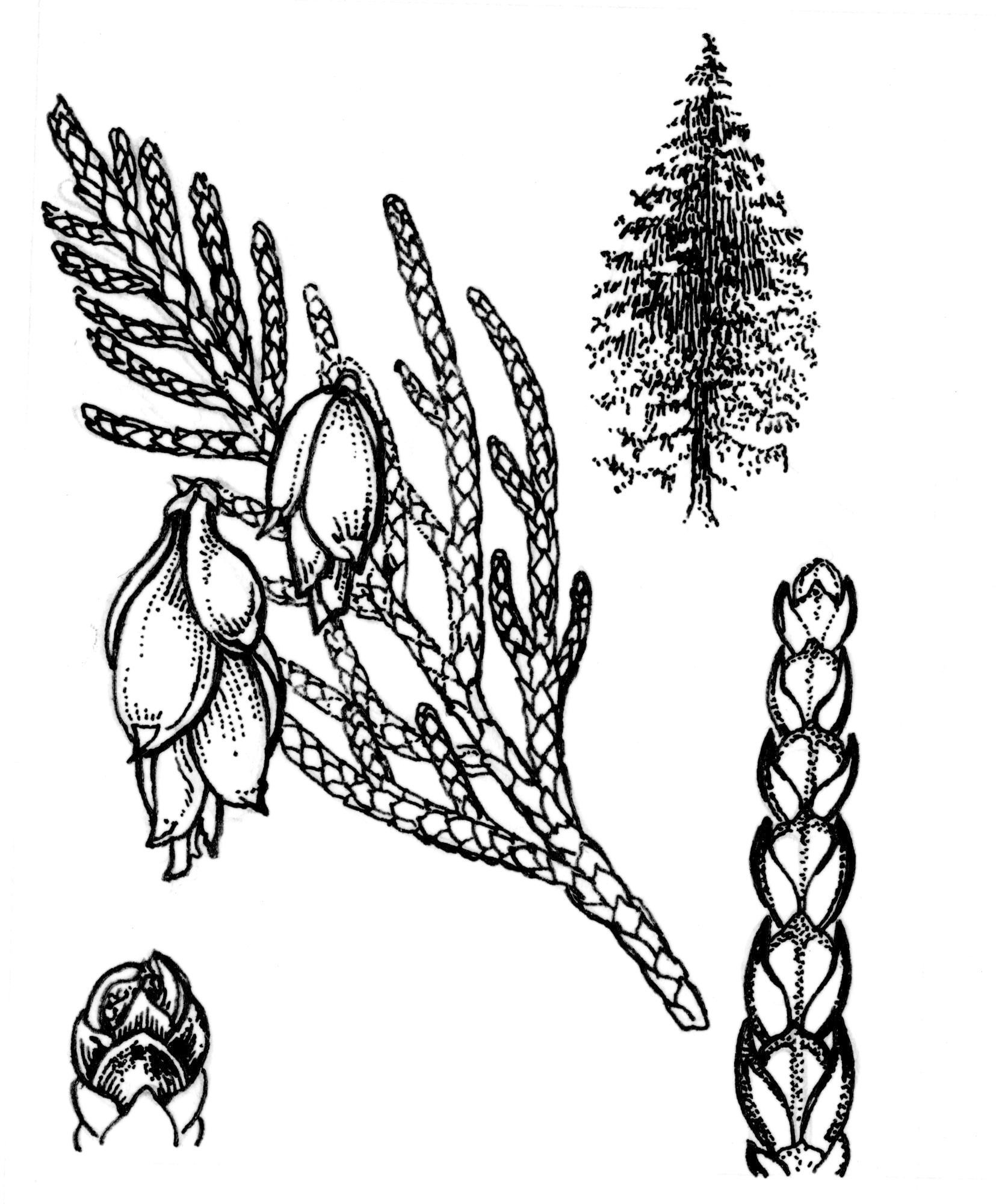
A large, conical tree to 50 m tall in nature but rarely more than 15 m or so in cultivation. Old specimens sometimes have a buttressed base with the branches arching to the ground and taking root. Foliage sprays flattened, glossy dark green above, pale below, strongly aromatic. Leaves 3-6 mm long with distinct white bands below. Mature cones 1-1.5 cm long, conical, red-brown; scales 8-10, 6 fertile, each bearing a sharp point near the tip. Seeds winged all around.
Grows naturally in moist areas or along montane watercourses to alt. 2000 m. Generally not suited to the climate of south-eastern Australia.
W North America.
Thuja plicata and T. occidentalis are sometimes difficult to distinguish from one-another. Apart from being a much larger tree when mature, Thuja plicata has larger leaves, very glossy above, with clear white markings below, and 6 (not 4, as in T. occidentalis) fertile cone scales. The cones are generally at least 1.5 cm long and do not open wide. In both species the cones pass through a yellow stage in development.
NSW: Mt Tomah (Bot. Gds); Mt Wilson ('Yengo' exceptional old tree ptd c. 1887); Sydney (Royal Bot. Gds). ACT: Westbourne Woods. VIC: Emerald (Heritage Nobelius Nursery Site); Mt Macedon ('Alton'; 'Forest Glade'). TAS: Hobart (Royal Tasmanian Bot. Gds).
Source: (1995). Cupressaceae. In: . Horticultural Flora of South-eastern Australia. Volume 1, Ferns, conifers & their allies. The identification of garden and cultivated plants. University of New South Wales Press.

With irregular yellow patches of foliage; a group name used for a range of yellow-foliaged variants. France nineteenth century. Vic: Emerald (Old Nobelius Nursery Site); Maryborough (Phillips Garden).
Small, broadly conical bush with green foliage tipped cream. Origin Blue Mountain Nsy, Tapuran, w Otago and introduced Ross Stuart's Nsy, New Zealand.
Fast-growing, broad, conical, with bright yellow foliage. Originating USA. c. 1985.
Slow-growing upright bush with foliage creamy yellow becoming coppery in winter. Originated e. Jenisch, Vienna, Germany, c. 1978.
Dwarf, broadly pyramidal. Foliage golden bronze, tips yellow. Originated and introduced W.H. Rogers Nsy, Chandlers Ford, UK, c. 1930.
Narrow and columnar with short branches. Origin Germany nineteenth century.
Thuja plicata 'George Washington'
Like a much brighter 'Zebrina'. Originating from America and imported as T. occidentalis to Australia by Mr Ron Radford who considered it to be a T. plicata.
Globose with bright golden yellow foliage. America but introduced by Grootendorst Nsy, Boskoop, Holland.
Dwarf, dense with branchlets in dense clusters at the branch tips. Turning brownish in winter. Hilliers Nursery, Winchester, England, c. 1900.
See Platycaldus orientalis 'Sieboldii'.
Erect, pyramidal shrub with golden branch tips, growing c. 4 m in 10 years, the colour changing to bronze in winter in cooler areas. Raised in New Zealand Millichamps' Nursery, Ashburton.
Dwarf, globose, becoming conical, slow-growing, leaves small and golden yellow-brown on the outside of the plant. 'Rogersii' is very similar. Raised W.H. Rogers, Southampton, England, c. 1928.
Retains rich green foliage colour throughout the winter. USA, listed for nurseries in Oregon.
Tall, conical, sprays yellow or white striped. Origin UK c. 1923.
Vic: Burnley College Gds; Castlemaine (Bot. Gds); Kallista (George Tindale Garden, at entrance); Maryborough (Phillips Gds).